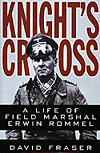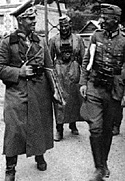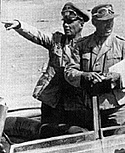 Published by HarperCollins Publishers, 1993.
Published by HarperCollins Publishers, 1993.
hardbound, ISBN: 0-06-018222-9
601 pages, plus 16 pages containing 32 B&W photos, 20 Maps, one appendix (Chronology of Rommel's Life), Bibliography, End notes, Index.
Knight's Cross: A Life of Field Marshal Erwin Rommel provides a biography of the acclaimed German officer, from his humble beginnings in a section of Germany called Swabia, through his rise in the German army during and between the world wars, to his death at the close of 1944. It exposes Rommel's character strengths and flaws, his actions and reactions to political events, and upholds as well as punctures the various myths surrounding his combat leadership.
It is the latter that draws us to the book, and author David Fraser centers on Rommel's uncanny ability to discern and exploit tactical advantages. The chapters covering his World War I service are particularly enlightening, detailing his actions in France at the opening of the war, a particularly good chapter about his efforts in the Romanian mountains, and his victories in the mountains of Italy. Fraser portrays Rommel as a shrewd judge of tactical maneuvers, being able to penetrate seemingly solid trench lines and working into the rear areas, demoralizing the enemy with speed and position as much as shot and shell. Rommel is a commander who leads from the front and excels in tight tactical situations, and anecdote after anecdote of wartime maneuverings dot the pages of the biography, making for a fascinating and quick read.
On occasion, this hard-charging attitude would generate trouble, as operating behind enemy lines had the tendency to get cut off and force a fighting withdrawal. Yet, as Fraser shows, Rommel could improvise with the best of commanders past and present, and the results were more often a success than a failure.
The Rommel Detachment
 For example, during the overall series of battles we know as Caporetto, the "Rommel Detachment" of the 124th Wurttemberg Regiment participated in the attack, driving the Italian army and capturing prisoners as it went. Over the course of several pages, Fraser delivers a concise and fast-moving narrative of the Rommel Detachment--three mountain companies and a machine gun company, and later expanded with an additional two machine gun companies--sneaking through the lines up a ridge near Luico and then overrunning Italian formations from behind.
For example, during the overall series of battles we know as Caporetto, the "Rommel Detachment" of the 124th Wurttemberg Regiment participated in the attack, driving the Italian army and capturing prisoners as it went. Over the course of several pages, Fraser delivers a concise and fast-moving narrative of the Rommel Detachment--three mountain companies and a machine gun company, and later expanded with an additional two machine gun companies--sneaking through the lines up a ridge near Luico and then overrunning Italian formations from behind.
- "This was fun!" Rommel wrote, "and no shooting! We had over 100 prisoners and 50 vehicles. Business was flourishing!" (p.70)
Soon, he outran even part of his command. With only 150 men, he then persuaded an Italian column (part of the Bersaglieri brigade) to surrender after a short, sharp firefight--another 50 officers and 2,000 men captured. Reinforced, he moved to the next hill, called for artillery fire, and grabbed 1,500 more prisoners from the Salerno brigade. After another firefight, his command nabbed another 1,200 prisoners off the final objective, Mt. Matajur. All told, the Rommel Detachment nabbed 9,000 prisoners at a cost of six dead and 30 wounded. After similar exploits on the Piave River, Rommel was awarded the Pour le Merite and posted as a junior staff officer at LXIV (Wurttemberg) Army Corps.
Although wounded, that Rommel survived WWI trench fighting on three fronts is testament to his skill and luck. Of the 46,000 regular German army officers, nearly 11,500 were killed in action. After WWI, the treaty limited the German army to 100,000 men, of which 4,000 were officers. Rommel, thanks in large part to his Italian successes, became one of those officers.
Post World War I
Fraser switches easily and generally effectively between the details of Rommel's life and the narrative of history. However, the author goes overboard on occasion, especially covering the years between the world wars. Fraser devotes much space to generic political turmoil and Rommel drops out of the book for too many pages at a time. Although generally covering Rommel's increasing admiration for Hitler with a skillful touch, Fraser at times loses control of the biographical narrative in favor of general history.
Fortunately, this minor faux pas ends with the beginning of World War II, with Rommel as head of Hitler's security detachment during the invasion of Poland. Here, Rommel attended daily briefings and gained an eagle's eye view of blitzkrieg in action. And here, he caught Hitler's eye once again, and became division commander of the 7th Panzer in time for the 1940 invasion of France.
Fraser cleverly develops the character of Rommel, letting it unfold against the tactical marvels of crossing the Meuse, leading supply columns, and pressing the attack. He integrates the enormous energy needed by Rommel to direct from the front with the authoritarian manner in which he deals with other officers, especially superiors. The mystique becomes more fragile than before, as a strong streak of vanity begins to appear, coupled with ambition and borderline arrogance--a part of Rommel that extends into his desert duty. Yet, he is still the master tactician, leading from the top of a tank and personally directing troop deployments while under fire.
On command of the 7th Panzer, Fraser writes:
- "What should be aimed for, as Rommel perceived very plainly and at every level, was paralysis of the enemy's will and of his capacity of clear thought and measured response, not simply or even primarily by physical destruction of his comunications and threat to his headquarters..." (p. 159)
Afrika Korps and D-Day
 With so many books written about WWII and the desert war, Fraser successfully resists the temptation to simply repeat history without insight. He delves into the minutae of Rommel's habits and actions, starting with the heady days of advance using a hodge podge of German, Italian, and captured British (and Soviet!) equipment, through the retreat, counteroffensive, and seizure of Tobruk. There is a good analysis of how Rommel planned his maneuvers, in part from information gleaned from his intelligence-gathering sources: including captured prisoners and especially decoded messages from an American officer attached as an observer to the British. Discussions of supply, the breakdown of Rommel's health, and the battles of El Alamein, the long retreat, and the offensive against the Americans in Tunisia are well tracked.
With so many books written about WWII and the desert war, Fraser successfully resists the temptation to simply repeat history without insight. He delves into the minutae of Rommel's habits and actions, starting with the heady days of advance using a hodge podge of German, Italian, and captured British (and Soviet!) equipment, through the retreat, counteroffensive, and seizure of Tobruk. There is a good analysis of how Rommel planned his maneuvers, in part from information gleaned from his intelligence-gathering sources: including captured prisoners and especially decoded messages from an American officer attached as an observer to the British. Discussions of supply, the breakdown of Rommel's health, and the battles of El Alamein, the long retreat, and the offensive against the Americans in Tunisia are well tracked.
Fraser shows Rommel's consistency in the face of the enemy, intermixed with growing doubts about the political situation and a growing awareness of Germany's worsening military situation. Fraser touches, albeit briefly in various parts of the biography, on the Holocaust, and Hitler's chilling reference to SS attrocites in Poland: "One does not make war with the methods of the Salvation Army."
 Yet it is also his visit with Hitler in 1943 that revives his enthusiasm--"under a sunray lamp," as Rommel puts it. Still, he understands the military array against Germany is too great. Coupled with reverses at Stalingrad and El Alamein, and Hitler's own melancholy pronouncement, "Nobody will make peace with me," Rommel knows the war is lost, but he still harbored hopes that the Anglo-Americans would hold the line against the Soviets.
Yet it is also his visit with Hitler in 1943 that revives his enthusiasm--"under a sunray lamp," as Rommel puts it. Still, he understands the military array against Germany is too great. Coupled with reverses at Stalingrad and El Alamein, and Hitler's own melancholy pronouncement, "Nobody will make peace with me," Rommel knows the war is lost, but he still harbored hopes that the Anglo-Americans would hold the line against the Soviets.
But if 1943 was bad, 1944 was worse. Fraser reveals the depth of Rommel's pessimism in a July 15, 1944 exchange with Colonel Warning, then a liaison officer to the Luftwaffe but also a staff officer of his during the African campaign. Warning asked how 12 German divisions were going to contain the entire Allied Invasion.
-
"I'll tell you something," Rommel replied. "Field Marshal von Kluge and I have sent the Fuhrer an ultimatum. Militarily, the war can't be won and he must make a political decision."
Warning looked at Rommel with astonished disbelief. "And what if the Fuhrer refuses?"
"Then," Rommel said, "I open the west front. There will only be one important matter left--that the Anglo-Americans reach Berlin before the Russians." (p.507)
Plot to Kill Hitler
Fraser spins the tale of Rommel's life through his wounding in an air attack, the increasing signs that the western front would collapse, and the conspiracy to kill Hitler. Fraser notes that while Rommel was sympathetic to the attempt, he disapproved of the assassination plan, fearing it would cause a civil war and make Hitler a martyr. Far better to proceed legally against Hitler, for he understood that the German Army must surrender to end the war--and the rank and file would not support a coup attempt in order to surrender. The entirety of chapter 23, "What Did Rommel Know?", analyzes the evidence for and against Rommel's participation in the assassination and projected coup--and is quite effective in doing so.
The last chapter, "A Necessary End," details the last day of Rommel's life, where Generals Burgdorf and Maisel delivered Hitler's own ultimatum: arrest and trial on charges of high treason, or, "the officer's way" with a full state funeral and statement that he died of natural causes. Rommel chose the latter, convinced that he would be killed before he could make any statements at a trial and assured that his family would remain untouched if he took the poison.
Overall
Fraser performs admirably in analyzing the character of Rommel through the years. He examines the myths that surround the Field Marshal's qualities of command without succumbing to hero-worshiping--indeed it is to Fraser's credit that he exposes the positive and negative sides of Rommel's actions. As Fraser puts it:
- Genius may sometimes break rules and evade the consequences. Rommel had genius. He broke rules. Sometimes, but not always, he evaded consequences. (p. 275)
That Rommel was shrewd and practical, thrifty and energetic, and a genius for improvisation are detailed as well as his ambition, vanity, and self-deception. Yet it is the imperfections coupled with the combat successes and ultimate failure that make Rommel as a biographical subject so interesting, and Fraser's deft touch that makes Knight's Cross: A Life of Field Marshal Erwin Rommel a fascinating read.
Photos from back jacket:
- Top: Rommel with Colonel von Bismarck during First World War.
Middle: Rommel with Colonel Fritz Bayerlein in North African desert.
Bottom: Rommel with General Gause, his chief of staff, in the desert.
Back to List of Book Reviews: World War II
Back to Master List of Book Reviews
Back to Master Magazine List
© Copyright 1996 by Coalition Web, Inc.
This article appears in MagWeb (Magazine Web) on the Internet World Wide Web.
Other military history articles and gaming articles are available at http://www.magweb.com